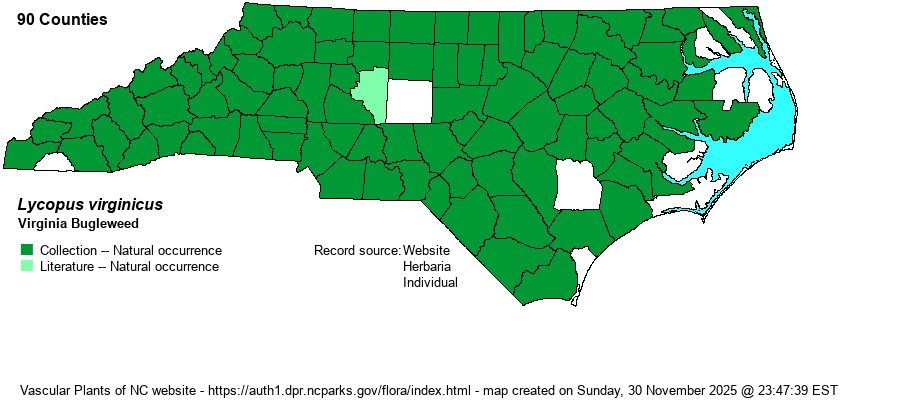| Author | L. | |
| Distribution | Statewide, and undoubtedly occurs in all 100 counties, though lacking records for 11 counties scattered over the state.
This is a widespread species in the Eastern U.S., occurring from southeastern Canada south to northern FL and eastern TX. It has been recorded from most counties within this large range. | |
| Abundance | Common statewide, except fairly common in the far eastern counties. By far the most abundant Lycopus in the state. | |
| Habitat | This species occurs in nearly all freshwater wetland habitats, favoring marshes, ditches, opening in bottomlands, and wet grassy places. |
| Phenology | Blooms from July to frost, and fruits shortly after flowering. | |
| Identification | This is the standard Lycopus to which all others should be compared, as it essentially occurs in every county in which a less common species is found. It has a slender stem to about 1.5 feet tall, often branched at the base. The many opposite leaves are mainly lanceolate to ovate-lanceolate, with the blade about 2-3 inches long and about 1-inch wide, with obvious but shallow teeth on the margins. This species has the longest and most obvious petioles to the leaves, with the leaf blade at the base having a concave curve to the petiole, which is slightly winged and often 1/2-1-inch long. The stem has tight whorls of small white flowers in the leaf axils, as do the others in the genus. See other species accounts for more details about separation from this common species. All biologists are familiar with this "default" Lycopus in the state, or at least should be. | |
| Taxonomic Comments | None
| |
| Other Common Name(s) | Virginia Water-horehound, American Water-horehound | |
| State Rank | S5 | |
| Global Rank | G5 | |
| State Status | | |
| US Status | | |
| USACE-agcp | OBL link |
| USACE-emp | OBL link |

